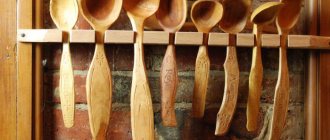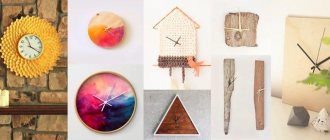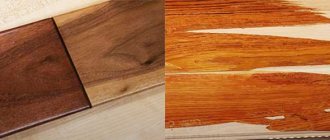Who invented the spoon and when?
The etymology of the word "spoon" is related to the Serbian root "lag", meaning a ravine or depression. In Rus' they used a different definition - the verb “lick” or “crawl”. Historians think that the appearance of the name in Rus' could be associated with the characteristics of the use of the device.
The Beginning of History in the Ancient World
The first spoons appeared much earlier than forks. Recessed appliances have traditionally been used for liquid or semi-liquid food. Archaeological finds are dated to the third century BC. The first prototypes of spoons were made from baked clay. The cutlery originally consisted of two parts: a handle and a main part.
To make a pen, bones, animal horns, pieces of wood or stone, sea shells and other objects were used as materials. The ancient Greeks did not give objects shape, but looked for objects with a depression.
Later, silver or bronze appliances began to be made for the homes of high-ranking persons from Greece and Rome. Although even the manufactured devices were used not for eating, but for cooking. Semi-liquid or liquid dishes were mixed in cauldrons or pans with silver scoops, and food was consumed with hands; special flatbreads were used for scooping, which became the prototype of pizza.
Middle Ages
The Middle Ages were characterized by the emergence of new materials for the manufacture of cutlery. Later, brass, copper and tin were used to make steel - such items were popular in the 15th century.
As for aristocrats and kings, they used cutlery made of silver or gold. For example, the mention of the royal golden spoon is associated with the name of the English King Edward, who took it with him everywhere. His spoon was marked “Parisian workshop”.
Renaissance
The Renaissance in Europe is associated with the appearance of apostolic spoons. In the second half of the 15th century, such items were gifts for Christian holidays. Apostolic spoons were made with the obligatory image of Jesus' disciple on the surface or depicted Jesus himself. During this period, the flat shape of the handle was invented, and the scoop began to look like an ellipse.
Age of Enlightenment
At this time, tea drinking culture, which was borrowed from the Chinese, began to spread. Historians call this time the era of the emergence of the teaspoon.
19th century
During this period, numerous cutlery factories were opened. For production, they began to use an alloy of copper with nickel or zinc. These metals were similar in appearance to silver, but were much cheaper - so cutlery became widely available. In addition, cutlery made of titanium appeared, which was called “cupronickel.” This is where the name for tea and coffee spoons came from, which were often combined with one meaning - “cupronickel silver”.
XX, XXI century
The twentieth century marked the beginning of the emergence of stainless steel. The addition of chromium reduced the degree of corrosion and increased resistance and durability. Today, cutlery is made from a variety of materials and metal compounds, but silver spoons are still considered the safest and highest quality.
What kind of wood are utensils made from?
The list of rocks from which dishes are made is long. This is due to regional characteristics. If, for example, in the north they made spoons, dishes and ladles from larch and birch, then in the middle zone - from oak, linden, ash, in Siberia - from cedar, in the south - from acacia and walnut.
Among the exotic breeds:
- teak;
- elm;
- rosewood;
- mango;
- Hevea
In Pomorie, craftsmen with their own hands carved magnificent ladles, valleys and brasses from tree roots, and dishes made from burls (growths on tree trunks) were also famous for their unique texture.
Nowadays, stores offer utensils made of strong and durable oak, acacia and ash, linden and bamboo. On trading platforms on the Internet there is a huge assortment of dishes for Asian cuisine made from suar, mango, and bamboo.
Materials and shape
Cutlery is classified according to materials and shape. The most common options:
- Stainless steel. This type of material is suitable for making spoons for daily use. It is distinguished by high quality, practicality and an affordable price.
- Chrome-nickel steel. Used in making everyday cutlery.
- Aluminum. Today this material is almost never used. It produces spoons that are rough in shape and execution. In addition, they bend easily and are difficult to wash.
- Tree. Wooden spoons are used today as a tool or as a decorative item.
- Ceramic. Ceramics are used to make decorative or gift items.
- Plastic. The material is used to make disposable or camping utensils.
- Silver. Beautiful, expensive material that is used to make sets. Silverware is often given as a gift for birthdays or anniversaries.
- Cupronickel. One of the most common materials, it competes with silver and does not darken over time.
In addition, spoons can have different shapes. Most of them are elliptical in shape, and the gravy boats have spouts. The scoops are more round and spacious.
ADZE
A type of chisel mounted on a handle, like an ax, with a semicircular tip. The metal tip is cut with the “back of the head” of the wide rounded end into the recess of a cut from a log, that is, a prepared buckthorn. They rubbed it with chalk to prevent it from slipping.
They especially loved those spoons that were given as gifts. They were painted with fabulous flowers and herbs. The shine of gold and cinnabar on them was perceived as a jewel and was associated with royal luxury.
Blanks for spoons
Such spoons were used for holidays, but on weekdays they continued to use unpainted spoons made of plain wood.
Semenov's spoons dispersed in all directions of Russia. Buyers even traded them abroad - in distant Persia. A special order for wooden spoons for soldiers of the tsarist army was also traditionally fulfilled by Nizhny Novgorod residents.
It is known that in the Semenovsky district at the beginning of the twentieth century, an average of 100 million spoons were produced per year, and in 1910 a record number was reached - 170 million pieces.
Coloring of spoons, Semyonov. Nizhny Novgorod province according to the research of the provincial zemstvo, 1896.
Spoon products were produced by thousands of artisanal peasants living in the city itself and in the surrounding villages. Each had their own specialization: spoon-carvers, dyers who painted “linen” (hollowed or machine-turned utensils), and varnishers, those who coated painted utensils with varnish.
The painting of wooden spoons had its own roots, which tied it to a particular area. From the drawing it was possible to immediately determine the homeland of the product. But whatever it was - curls or diamonds, meanders or loops, ovals, circles or dots, all this was collected into a single picture of nature, its beginning, the triumph of fertility and happiness.
Each spoon maker had his own painting technique, but local customs and traditions always served as a source of inspiration. The master selected bright, expressive colors - sunny yellow, honey, emerald green, etc. And so that the newly applied drawing is not eaten along with the stew, a spoonful of oil is added. Calcined vegetable oil was used for this. And so, an almost weightless painted spoon with an elegant oval-shaped scoop and a comfortable rounded handle (holder) turned into a real beauty, dressed in a golden outfit. This is how the spoon appeared - the main cutlery of all peoples and classes without exception.
Types of spoons
Spoons today are classified according to their main purpose, shape, and type of manufacture. Table with main types.
| Dining room | Suitable for first courses or porridges from deep bowls. Typically the volume of a spoon is 18 milliliters. |
| Dessert | Used for desserts, small plates or bowls. Volume – no more than 10 milliliters. |
| Teahouse | Suitable for stirring sugar in tea, capacity is 5 milliliters. |
| Coffee shop | Designed for latte, cappuccino, espresso coffee; it is used to mix in sugar. The capacity is 2.45 milliliters. |
Auxiliary spoons
In addition to basic cutlery, there are auxiliary ones.
| Barnaya | The special feature is the spiral and elongated handle, which is equipped with a ball-shaped tip. Bar spoons are used for stirring cocktails, and the ball is used for kneading berries or ice cream. |
| Bouillon | This device is only common in Asian restaurants. It has a complex design. |
| For absinthe | A device with a complex figurative shape, it is designed to hold a piece of sugar. Absinthe is usually poured on top. |
| Fruity | In appearance, the spoon resembles an ordinary cutlery, but is equipped with notches on the sides intended for kneading the pulp. |
| For olives | A spoon with a long handle and a special hole for draining liquid. |
| Sauce | Sauce utensils are equipped with a spout for pouring liquid carefully and in portions. |
BUCKLE
This is the initial blank for the future spoon. That is, a piece of split log is shaped. At one end it remains wide, and then narrows, cutting off half of its thickness.
First, it was necessary to trim a wooden block to form the frame of a spoon. Then use a knife to process and round the workpiece, giving it the lines of the future tableware. And then the cutters were used, with which the desired recess was selected. Before painting, the spoon was dried so that the paint adhered well to the surface. But then came the miracle.
Spoons as a musical instrument
Wooden spoons are said to be the most famous musical instrument. The wood for them is varnished to achieve the best possible sound. The devices are traditionally used in pairs. Sound is produced by hitting spoons on the palm or other surfaces.
This is an old percussion instrument, a set can include from 2 to 5 pieces. At the same time, the largest spoon accommodates all other utensils in size. The main spoon is called large, and the rest are called “fan” spoons.
Proper care and operating features
After the dominance of plastic and other “synthetics” in kitchens, many are again turning their attention to natural materials. Of course, wood is not suitable for making pots and pans.
But dishes, trays, cutting boards, containers for storing, pickling, preserving and serving cold dishes made of oak, juniper, teak, and bamboo turn out great.
Such utensils are not only safe and hygienic. It pleases the eye, attracts with positive energy, and significantly improves (if used correctly) the taste of dishes.
But in order for the utensils to serve for a long time, you need to know and follow simple rules:
- It is advisable to purchase products from trusted sellers who have certificates of product quality and safety;
- use utensils taking into account the manufacturing methods. Painted and varnished items are only suitable for interior decoration;
- prevent prolonged contact of products with water;
- store in dry, ventilated cabinets, away from heating radiators and household appliances;
- Wash only by hand, in warm water and then wipe the products thoroughly.
Flour, salt, sugar, honey, and baked goods are perfectly stored in wooden dishes. Barrels, tubs made of juniper and larch are suitable for pickles and preservation.
When cooking, you cannot do without wooden mortars, spatulas, and boards, and sliced meats and cheeses look incomparable on massive board trays made of oak, acacia or teak.
Only cold dishes are served in bowls and wooden dishes: various salads, appetizers, marinades, pickles, soups (okroshka, beetroot soup).
On a note! Do not use a dishwasher to wash wooden utensils.
To remove extraneous odors, it is recommended to occasionally wipe the surfaces of objects with a cloth soaked in a vinegar solution.
Interesting facts and traditions
There are many interesting facts associated with tablespoons:
- Barge haulers wore a spoon on their headdress. They secured it with a cockade. When the barge haulers were given lunch, they took out a spoon and used it for its intended purpose. After the meal, they shook it off and then put it back in place.
- During the existence of the Turkish Sultanate, a coat of arms was created with the image of a spoon in the center. Thus, the Sultan made the Janissaries understand that they were fighting for a reward.
- It was a custom in Cambridge for many years for the student who scored the lowest in mathematics to be given a wooden spoon.
- Salvador Dali used this cutlery when he fell asleep. He held it suspended in his hands, and when he fell asleep, the spoon fell, Dali jumped up and sketched what he dreamed.
- In Scotland, for a long time there was a sign associated with cutlery. The mother watched with which hand the child would take the spoon for the first time. If he did this with his left hand, then the mother began to cry, since the sign said that the child would not see happiness.
- The French came up with a device with a hole in the center, in this way they offered the residents of the country to lose weight.
- It is known that throughout the 18th century, aluminum instruments were made for aristocrats. At that time, aluminum was valued higher than precious metals.
Signs and fortune telling
In Rus', each family member had their own, so they often carried it with them either in a special bag or in the top of their boots. This is where the expression came from: “To someone else’s table, but with your own spoon.”
Everyone knows the sign that has come down to us - a spoon fell from the table - expect a woman to visit, a knife fell - a man.
In the old days, entire families used them to tell fortunes. The most famous was fortune telling using a barrel of water. At night, each family member put his own spoon in a barrel filled with water. They shook the container well, and in the morning they looked at how they were located there. If everyone is huddled together, it means that love and mutual understanding will reign in the family for a whole year. If one or two separate, then their owners will face departure from their home, or a quarrel with the others.










